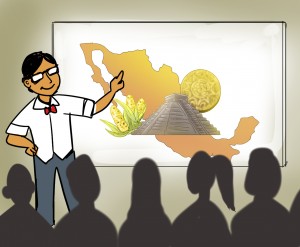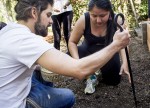Eduardo de la Cruz intones a ritual prayer to bless seeds of corn in a UCLA professor’s backyard one Friday afternoon.
Earlier that day, a group of UCLA students dug little holes in a patch of soft dirt in preparation for the blessing. One by one, they offer food to a ceremonial altar decked with coffee and sweets. Two by two, they kneel to the ground and plant four seeds of corn in each awaiting hole. De la Cruz, a native of Veracruz who wrote his master’s thesis on the role of corn in indigenous Mexican communities, leads the traditional maize planting ceremony.
But de la Cruz, who teaches Nahuatl through the UCLA Latin American Institute, doesn’t normally get the opportunity to raise crops with his students. De La Cruz lives in Mexico, and teaches the native language of his hometown to UCLA students Mondays and Wednesdays through teleconference. Once a quarter, he visits California to engage with his students and his co-instructor in the course, Kevin Terraciano. Last week, de la Cruz used Terraciano’s backyard as the stage for the ancient agricultural ritual.
Terraciano, director of the Latin American Institute, established the elementary Nahuatl program in November to foster the growth and teaching of uncommon languages in Latin America. Nahuatl, historically known as the language of the Aztec empire, is an endangered tongue, he said. More than 120 million people live in Mexico today, but only about 1.5 million speak Nahuatl.
As part of the program, funded by a $2 million grant from the U.S. Department of Education, about 12 students meet in Powell’s Media Lab for two hours every Friday to conference remotely with de La Cruz and a Nahuatl class at Stanford University. Students focus on themes associated with Nahua culture, such as preparing and planting food.
“If people speak more than one language, they become able to understand different cultures,” said de la Cruz, speaking through a translator. “By learning Nahuatl, we are trying to better understand this community.”
Nahuatl was a common Mesoamerican language spoken from the seventh to the 16th century, during the reign of the Aztec empire. However, many indigenous Mexican languages – and their speakers – have since been marginalized, oppressed and even persecuted, Terraciano said.
<iframe width=”100%” height=”450″ scrolling=”no” frameborder=”no” src=”https://w.soundcloud.com/player/?url=https%3A//api.soundcloud.com/tracks/260753681&auto_play=false&hide_related=false&show_comments=true&show_user=true&show_reposts=false&visual=true”></iframe>
“‘Indigenous’ is a derogatory word in Mexico and Guatemala,” he added. “Even today, stigma (exists).”
Indigenous Mexican races exist all around us, within Los Angeles and the university itself, Terraciano said. For example, some speakers of Zapotec, the tongue of a pre-Columbian civilization from present-day Oaxaca, live in Santa Monica and Venice. He added a community of Mixtec speakers live in coastal Oxnard, while a group of Nahuatl speakers occupy suburban Santa Ana.
Terraciano, a scholar of Nahuatl textual artifacts, said his daughter’s sixth grade class inspired him to bring Mesoamerican history to local schools.
Two years ago, Terraciano watched his daughter learn about ancient civilizations at the Lab School, a private academy run by the UCLA Graduate School of Education & Information Studies. The kids learned about ancient Greece, Egypt, Mesopotamia and Rome – standard civilizations covered in pre-modern history lessons. But they didn’t cover Mesoamerica, though a significant portion of the class came from Latin American regions such as Oaxaca, Guatemala and Mihuacan. Terraciano said he even met a Zapotec family in his daughter’s class.
About two years ago, Terraciano and his wife began to work with teachers at the Lab School to write bilingual lesson plans about Mesoamerican culture. Now, he wants to introduce Mesoamerican history to curricula at the statewide level by creating lessons integrated with books and other readings.
“It’s important to acknowledge how rich (Mesoamerican history) is,” he said. “It’s not a dead civilization, it’s a living culture.”

During class, de la Cruz discusses Nahuatl vocabulary with his students in rapid Spanish, his speech clicking and flowing smoothly. For many of his students, Spanish is a native language – four students identify as Chicana/o and three are from Mexico, Terraciano said. One student, who comes from a Nahuatl region of Mexico called Guerrero, told Terraciano she feels more connected to her grandparents after learning the language.
AJ Meyer, a graduate student in art history, said he plans to conduct fieldwork in Mexico and perhaps use Nahuatl to analyze codices in pre-Columbian art.
Meyer said he thinks the most fascinating aspect of Nahuatl is how its words reflect the speaker’s understanding of the world. For instance, people discussing objects in front of them will use the Nahuatl word for “face,” xi, in their speech. Numerous locations in Mexico are also derived from Nahuatl – the city Xochilmico, for example, means “field of flowers.”
More than 10 years ago, the Latin American Institute launched a program focusing on the Kichwa language, a tongue native to the Andean region of South America. Terraciano said he hopes to create a second year of classes for intermediate Nahuatl and bring together students from all over the U.S. to create an indigenous Mexican culture summer institute.
“I consider Los Angeles to be the northernmost capital of Latin America, (because of) its historical and cultural proximity to Mexico,” he said. “It’s important to educate everyone in the community on the importance and sophistication of these cultures.”
Email Ong at aong@media.ucla.edu or tweet her at @allison_ong7.
